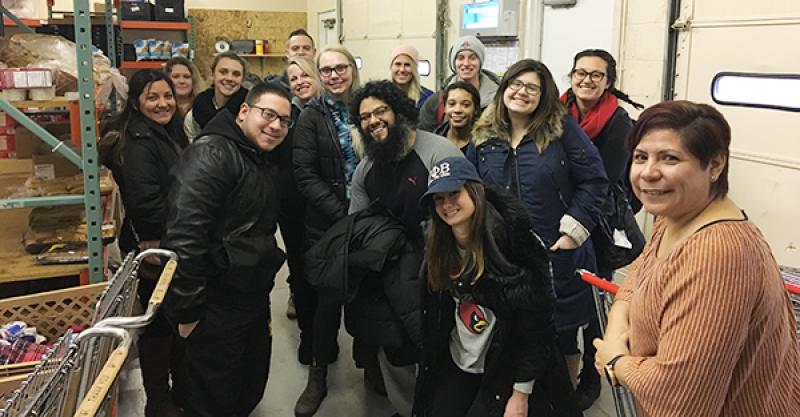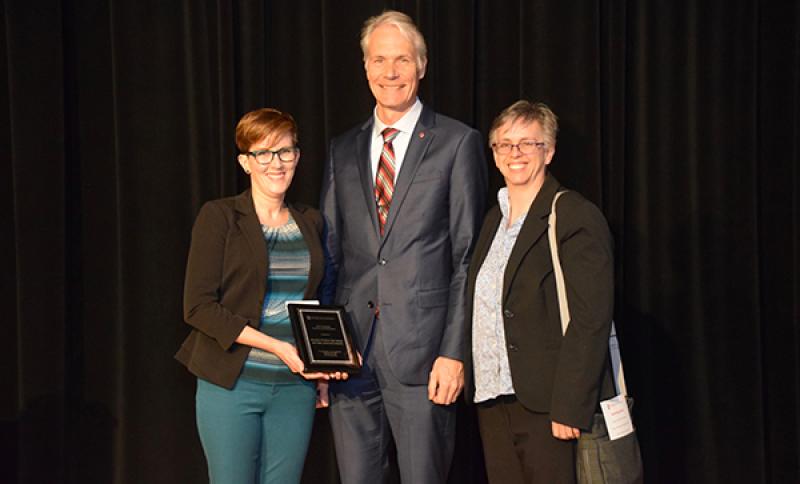Service-learning experiences provide profound learning opportunities


Students of Elena Foulis' course "Spanish in Ohio: An Experiential Course" at the Our Lady of Guadalupe Center in Columbus in 2018.
On paper, service-learning courses mark a few more notches on a student’s credit-hour quota.
But in reality, the classes’ influences on hearts and minds can’t be quantified. How do you measure the rich connections between students and communities, the profound experiences that inspire career paths, or the self-reflection and growth sparked by new and fulfilling challenges?
Service-learning combines academic curriculum and community service, and the College of Arts and Sciences faculty who lead these courses see these deeper effects on their students year after year. Ask them for an anecdote and they have a hard time picking just one.
“Our students become collaborators and advocates in different ways,” said Elena Foulis, who teaches “Spanish in Ohio: An Experiential Course.” “I have a student who in class worked with the Ohio Commission on Hispanic/Latino Affairs in class, and this year they hired her.”
“I had a young woman who wasn’t sure what to do after graduation,” said Linda Mizejewski, who teaches “Feminist Perspectives on Addiction, Service Learning.” “After the course, she said, ‘I love teaching high school. I want to work with high school students,’ and she got into a master’s program of education because of this experience, which is remarkable.”
“One of our students decided to become a speech language pathologist because of this course,” said Marla Berkowitz, who co-teaches “Intersection of American Sign Language, Deaf Culture, and the Deaf Community” with Kristin Wickham-Saxon. “Another student went on to work closely with a domestic violence organization. Another student is studying to become a physician, and that means you’re going to have a physician who knows sign language. Can you imagine? Deaf people would be so thrilled to find just one physician who knows sign language.”
The College of Arts and Sciences’ service-learning footprint is felt across central Ohio in schools, libraries, clinics and nonprofits, and the impression left on students is matched only by the impression left on the community. During the pandemic, instructors, students and community partners adapted to maintain their connections, and for many, those relationships are more vital than ever before.
Community-centered curriculum
When Foulis, senior lecturer and service-learning and heritage language coordinator in the Department of Spanish and Portuguese, took over “Spanish in Ohio: An Experiential Course” 10 years ago, it wasn’t yet a service-learning course. The students, however, were already volunteering with Latinx community organizations in central Ohio. So when Foulis applied for a service-learning designation, it was a natural fit.
Now, Foulis, her course and her students are well-known within the local Latinx community.
“We have well-established community partnerships, and because I’ve been working with them for such a long time, they already know when my students email them that they’re coming from my class,” Foulis said. “They know what type of student they are and what’s expected of them.”
Foulis’ students work with a variety of organizations, such as the Ohio Commission on Hispanic/Latino Affairs (OCHLA), Proyecto Mariposas, the Our Lady of Guadalupe Center, Columbus City Schools and Mount Carmel Health System. The diverse network of partners allows Foulis to attract students studying a broad range of disciplines, from social work and public policy to education and pre-med.
In spring 2020, Foulis, her students and the community partners had to abruptly continue their interactions remotely. Mentorships and workshops pivoted to virtual, and some students began working with their partners to make face masks. It was a learning experience that allows for more flexibility in autumn 2021.
“We’ve had a year of learning to adapt and to find solutions to overcome the limitations we might have,” Foulis said.
The students push themselves to use their language skills, and that does make them a little worried, but by the end of the semester, they see their own growth and understanding of a community that exists within their neighborhoods in a more real and personal way.”
“Feminist Perspectives on Addiction, Service Learning” continues the vision set by 2018 President’s Prize recipient Alina Sharafutdinova, whose project involved teaching Health Opiate Prevention Education (HOPE) curriculum in underserved Columbus public schools. Sharafutdinova realized the curriculum, usually taught by high school teachers, would be more effectively taught by instructors closer to high school students’ age. When she led the lessons, students were more engaged and receptive to her than to their teachers. After her President’s Prize funding ended, the torch was passed to Mizejewski’s service-learning course through a grant awarded by the Global Arts + Humanities Discovery Theme.
“Now we have Ohio State students going in and leading discussions,” said Mizejewski, an Arts and Sciences Distinguished Professor in the Department of Women’s, Gender and Sexuality Studies. “The high school teachers report that attendance is much better when our students are there, and when they get into these small discussion groups, the students are asking things like, ‘So what’s college like? How do you get into college?’ These classes are taking place in neighborhoods that have been hit hardest by the opioid epidemic, and we’re realizing these kids don’t know a lot of people who went to college.
“I talked to a social worker who said that a lot of these kids have lost parents to overdoses. It’s a very common thing — in classroom of 30 kids, figure several of them have been affected in very personal ways.”
The course was a success when students entered high school classrooms in 2019 but was cancelled in 2020 due to the coronavirus. This autumn, Mizejewski’s students will meet with high schoolers facing steeper struggles than those from two years ago. They’re in communities more adversely affected by the pandemic and where an already dire opioid crisis got worse.
“What are the conditions that make addiction possible? What are the public policies that attempt to treat addiction? How are both the causes and policies affected by gender, race and class?” Mizejewski said. “We’re trying to address those problems.”
Wickham-Saxon, a senior lecturer in the American Sign Language (ASL) program, proposed the course “Intersection of American Sign Language, Deaf Culture, and the Deaf Community” after a colleague pointed out how the Deaf community was sharing so much knowledge but wasn’t receiving anything in return.

Ola Ahlqvist (middle),Associate Vice Provost for Academic Enrichment, presents Kristin Wickham-Saxon (left) and Marla Berkowitz with the 2019 Emerging Service-Learning Award.
“And that really stuck with me,” she said. “I was like, ‘Yeah, we need to get our students out in the community and engaged in service learning.’”
Now, the course is entering its sixth iteration, and Wickham-Saxon and Berkowitz have curated a diverse network of community partners in a city home to the largest Deaf and hard-of-hearing community in Ohio. From nursing homes and schools to domestic violence nonprofits and agencies that serve populations with other disabilities, Wickham-Saxon and Berkowitz have partnered with 16 different organizations.
“I want to offer as wide a range of experiences to students as possible,” said Berkowitz, also a senior lecturer in the ASL program. “We are so incredibly fortunate to have the strength of this community in our backyard.”
Students embed themselves within these organizations not just to increase their proficiency in ASL, but to cultivate intercultural competence and expand their understanding of their own power and privilege. Students may assist understaffed organizations with administrative duties, event planning or social media, but they leave their experience with deeper grasps of intersectional oppression, accessibility and equity.
During the height of the pandemic, Wickham-Saxon and Berkowitz’ students also learned the value of adaptability. Many in the Deaf community felt more isolated as stay-at-home guidelines were established to curb COVID-19, and students took steps to protect their bonds as much as possible.
“They found such creative ways to stay connected with the people they were working with,” Berkowitz said.
We encourage the students to find ways to stay connected through their service learning, but it was incredibly impacted, and it just shows that relationship of care of super critical.”
'Personal growth is the main objective'
Students at Ohio State yearn for opportunities to make positive differences beyond campus. They were already forging relationships before Foulis’ course formalized its service-learning aspect. When Mizejewski asked a separate class if they’d be interested in a volunteer assignment, hands shot up. Wickham-Saxon and Berkowitz feel their students’ desire to come away from college with more than just a degree — they sense a longing to be part of a bigger world.
And those impacts are felt within the communities.
“We’re a land-grant institution, and that means we have a responsibility to share our resources,” Mizejewski said. “Some of our resources are these students who are enthusiastic and who want to help. This isn’t just volunteer work; these are regular college courses, and that knowledge is power. We need to extend that power into the communities by empowering others.”
Community service, Berkowitz believes, requires one to think about their intentions. Community service is for college credit. It looks good on resumes. It helps people. It broadens horizons. But beneath those conscious motivations are opportunities to be open-minded, self-contemplate, become comfortable with being uncomfortable, and embrace struggle.
Personal growth is the main objective," Berkowitz said. “I think life is all about having to struggle. Real life is struggle, right? It doesn’t mean we are defeated. Struggle means you are learning, figuring out how to navigate waters you’ve never been in before in the journey you are about to embark with openness.”
